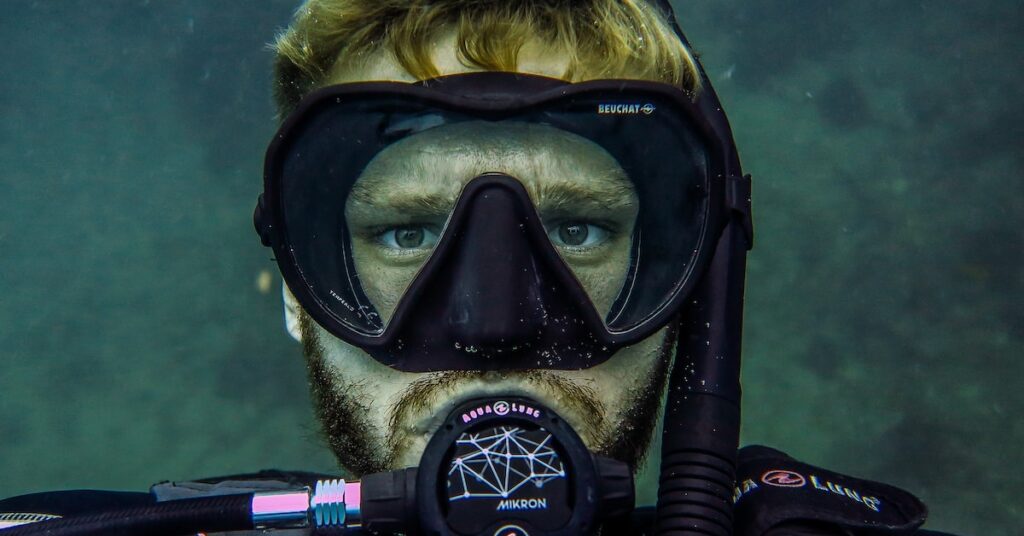

You can use a low-volume mask for scuba diving, and some divers prefer these over full size options. The choice mostly weighs on how comfortable the mask fits on your face, so it changes from person to person.
Keep reading as we explain what many low-volume mask details, including their pros and cons. We’ll also touch on other mask types so you can choose the one that works best for you.
What Is Low-Volume Dive Mask?
A low-volume dive mask is a mask with a lower profile. They sit closer to the face than full-size mask options. Before these were adapted to use by scuba divers, low-volume masks always held less than 100 ml.
Low-volume masks now hold smaller amounts than normal masks, but they aren’t subjected to any certain limit. Most marketed for sporting make this distinction by using the terms “ultra low-volume” or “micro mask”.
Advantages of Low-Volume Masks for Scuba Diving
Scuba divers may choose a low-volume mask for any number of reasons.
Because they have a slimmer profile, you use less air when equalizing. You also take on less water if your mask seal breaks, and it can be easier to clear. The masks can also have softer skirts, so you’re using less breath and force when clearing. Not only is this easier, but you reduce the risk of losing control of buoyancy.
Most of these masks cover a wide field of vision. They usually have lens shapes that make it possible to look down without straining your neck. Some have peripheral fields that put high volume masks to shame.
Low-volume masks feel lighter and fit better on smaller faces. They reduce drag, and may be more comfortable for certain divers. They also work better for prescription lenses, and may be a great choice for those who travel frequently.
Disadvantages of Low-Volume Face Masks for Diving
The small size of low-volume masks leaves some divers feeling restricted or claustrophobic. They don’t fit well on larger faces and/or noses, and divers with long lashes might have problems as well.
Few low-volume masks come with continuous faceplates, so those who prefer that view won’t have many options. Certain models also limit your peripheral vision.
Low-volume masks work poorly in cold water. Because there is less air, they don’t insulate as well. Those who get cold easier may want to avoid them altogether.
What Are Low-Volume Masks Used For?
Low-volume masks are often used by scuba divers that want to conserve their breath while diving or those who want a mask that is easy to clear. They’re also a popular choice for:
- Divers with smaller faces that have issues finding a mask that fits
- Divers who want to check gauges without bending their head
- Those with prescription lenses
Besides this, low-volume masks were almost exclusively used for freediving and spearfishing before scuba divers picked them up.
Can You Use Any Mask for Scuba Diving?
You should use a mask specifically designed for scuba diving. These masks must meet certain criteria to hold up to the depths and demands of scuba diving.
For example, scuba diving masks cover your nose. While this seems uncomfortable, it accomplishes something that regular swimming goggles cannot; it provides you with air needed to equalize your ears.
Regardless of what type of mask you choose, there are certain things to look for.
What to Look For in a Mask for Scuba Diving
First and foremost, you want a mask that fits your face comfortably. You can spend your time looking for the perfect fit, or you can dish out some extra cash to get one professionally fitted.
This looks (and feels like):
- A mast that stays on your face without you holding it
- A mask that is difficult to remove while you continue to gently breathe through your nose
- A mask with a good field of view
Make sure you try your mask on with your snorkel and regulator in your mouth. This shouldn’t affect the fit in any way if the mask fits well.
After you ensure a correct fit, you can look for special features such as:
- Low-volume or profile designs that are easier to clear
- Finger pockets around the nose
- Softer mask skirts
- PRescription lenses
- UV and glare protection
Without ensuring these things, you can end up with a practically useless mask that leaks, feels uncomfortable, and fogs up frequently.
What Is the Best Mask to Use for Scuba Diving?
The best mask for scuba diving is one that meets the criteria listed above. Most recreational divers get by fine with a single or dual lens mask that fits properly, while technical divers may opt for low-volume masks with comfortable fits and options to mount accessories.
- Single lens: offer a wider field of view; comfortable for most
- Dual lens: teardrop shape lenses make looking down easier; low-volume; work with corrective lenses
- Tri lens: a single lens with clear windows on either side; increase peripheral vision; truer colors and clarity
- Full face: covers entire face; mostly for professional situations; work well in cold water; may have integrated intercom system; no need to hold diving mouthpiece
Do your best to find a mask cleared for scuba diving that fits you well and offers all the features you want.
References
https://www.scubapro.com/blog/article/best-scuba-mask
https://www.scubatude.com/blog/scubatude_blog/how-to-choose-the-right-mask-for-scuba-diving
